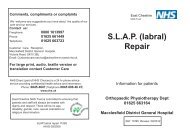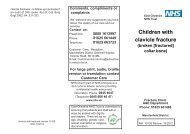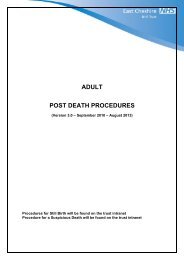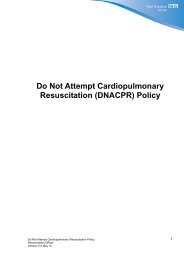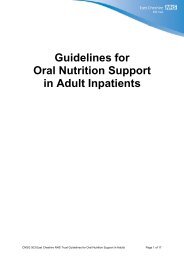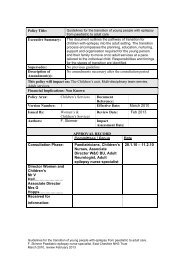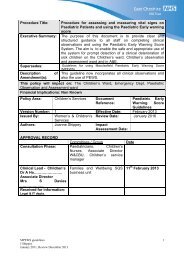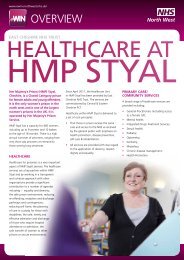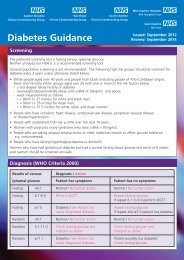Annual report 2010/11 - East Cheshire NHS Trust
Annual report 2010/11 - East Cheshire NHS Trust
Annual report 2010/11 - East Cheshire NHS Trust
Create successful ePaper yourself
Turn your PDF publications into a flip-book with our unique Google optimized e-Paper software.
<strong>Trust</strong> support for armed forces<strong>East</strong> <strong>Cheshire</strong> <strong>NHS</strong> <strong>Trust</strong> has been recognised for its supportof armed forces this year by being presented with a largecommemorative print of a picture called ‘Safe Return’ byCommanding Officer Colonel Kerry Trow from 207(Manchester) Field Hospital in gratitude for the trust’sefforts in overseas missions. “207” is one of elevenTerritorial Army (TA) Field Hospitals whose role is to providemedical support to UK Forces on operations overseas.“207” ran the British Military Hospital in Iraq for part of2004 and returned in January this year from a deploymentto Afghanistan where they ran the Military Hospital inCamp Bastion.Several members of <strong>East</strong> <strong>Cheshire</strong> <strong>NHS</strong> <strong>Trust</strong> staff volunteerwith the Territorial Army Medical Services Unit includingHelen Archer, Operating Practitioner and Steve Booth,Transfusion Practitioner.Volunteers undertake a ‘tour of duty’ for which they receivetraining and preparation.Corporals Helen Archer and Steve Booth made a vitalcontribution to 207 Field Hospital’s deployment toAfghanistan earlier this year, where they helped to run theMilitary hospital at Camp Bastion. Both were involved inproviding first class care for British and US servicemen andwomen in what has been <strong>report</strong>ed as the “busiest traumacentre in the world”. This support is vital to reservists andmakes operational deployment and their continuedinvolvement with the TA possible.Our volunteers experience with the 207 (Manchester) FieldHospital (Volunteers) Medical Services Unit has enabledthem to develop many skills and qualities which haveoffered benefits to the trust and our patients.Key improvements include:• Changes to the massive haemorrhage protocol for themanagement of patients experiencing massive blood lossat <strong>East</strong> <strong>Cheshire</strong> <strong>NHS</strong> <strong>Trust</strong>.• Changes to the trust’s major incident protocol, which aimsto improve the trust’s planning and response to anyincident with major consequences for health or healthservices in partnership with the emergency services, localauthorities and others.• Our volunteers have delivered a series of educationalpresentations to highlight their experiences and shareskills with the trust’s clinical staff – for example TheMidwives and Nurses Day staff conference 20<strong>11</strong>.Sustainable developmentSustainable development, in particular carbon reduction,has become an increasingly important national priority, withthe UK committed to reducing carbon by 80% by 2050.<strong>East</strong> <strong>Cheshire</strong> <strong>NHS</strong> <strong>Trust</strong>s strategy to reduce carbonemissions concentrates on the following areas:1. Energy and carbon management2. Procurement and food3. Low carbon travel, transport and access4. Water5. Waste6. Designing the built environment7. Organisational and workforce development8. Role of partnership and networks9. Governance10. FinanceDuring <strong>2010</strong>/<strong>11</strong> the trust built upon previous high levelactions by carrying out an independent assessment of thedistrict general hospital site including the main nucleusbuilding and all ancillary buildings. This assessment willform the baseline for the trusts improvement programme.The assessment tool used (BREEAM Healthcare XB) wasdeveloped by the Building Research Establishment on behalfof the Department of Health with the aim of enabling <strong>NHS</strong><strong>Trust</strong>s to:• improve efficiency of their existing building portfolio• improve the indoor environment of their occupiedbuildings, with the result of increasing staff andpatients' wellbeing• reduce energy waste and, consequently, reduce utility bills• demonstrate commitment to sustainable development.Whilst the results showed that the trust performedrelatively well in terms of sustainability and environmentalperformance there were areas of weakness which meantthat certain buildings including the main nucleus and <strong>Trust</strong>Headquarters failed to meet the minimum scorerequirement for certification.A full set of recommendations for score improvement wasalso commissioned and this will inform the trusts action planfor 20<strong>11</strong>/12.The trust also commissioned aerial thermal images to showareas of significant heat loss the findings of which wereconsistent with the above assessment.A long term lease was also agreed on a new office blockbeing built on the ‘Blue Zone’ area of the district generalhospital site. As part of that agreement the trust requiredthat the building meets the highest possible environmentalperformance standard for a new building (BREEAMExcellent) and that this is independently certified uponcompletion. The trust will take occupation of this buildingduring 20<strong>11</strong>/12 and thereby reduce carbon emissions andenergy usage still further by vacating less efficient premises.5859





